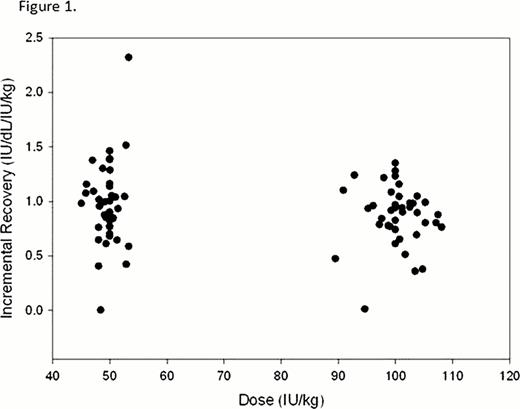Abstract
Abstract 4628
Hemophilia B is an X-linked coagulation disorder characterized by a deficiency in factor IX (FIX), which results in spontaneous or trauma-induced bleeding primarily in joints, muscles, and soft tissues. Prevention and treatment of bleeding episodes in patients with hemophilia B is based upon replacing deficient FIX, either prophylactically or on an on-demand basis, with plasma-derived or recombinant FIX products. Prophylaxis therapy (ie, long-term, regular treatment) with FIX products is endorsed by the World Health Organization, World Federation of Hemophilia, and National Hemophilia Foundation as a primary therapeutic option for individuals with severe hemophilia B. Still, the use of prophylaxis is underutilized, as shown in data from North American and European hemophilia centers, where only 21% to 55% of individuals with hemophilia B were identified as receiving prophylactic FIX therapy (Rocca A et al. Blood Transfus 2011;9:60; Aznar JA et al. Haemophilia 2011;17:542; Biss TT et al. Haemophilia 2008;14:923). Factors implicated for this phenomenon include difficulty in venous access (particularly with primary prophylaxis in children), as well as overall adherence and willingness to commit to a highly demanding treatment schedule (Valentino LA. Haemophilia 2004;10:147; Collins PW et al. Haemophilia 2011;17:2; Santagostino E. Haemophilia 2010;16:13). The potential benefits of utilizing a once-weekly prophylactic regimen versus a more frequent dosing regimen include increased convenience for patients and their caregivers owing to fewer infusions and less preparation and infusion time, and the preservation of venous access.
This study aimed to compare the safety and efficacy results for 2 prophylaxis regimens of nonacog alfa in moderately severe and severe hemophilia B patients.
This multicenter, open-label crossover study enrolled 50 patients with moderately severe or severe (FIX C ≤ 2%) hemophilia B. Patients were treated on demand for 16 weeks, and 47 were subsequently randomized to 1 of 2 prophylactic regimens (nonacog alfa 100 IU/kg once weekly or 50 IU/kg biweekly) for 16 weeks. Following the initial prophylactic regimen, patients underwent an 8-week washout period of on-demand (OD) therapy then were crossed over to receive the other prophylactic regimen. The primary end point was the annualized number of bleeding episodes, expressed as the annualized bleeding rate (ABR). The results of this study were previously reported (Valentino LA, et al, 2011 ISTH abstract 1293).
Comparisons between once-weekly and twice-weekly prophylaxis regimens are given in Tables 1 and 2 and in Figure. No thrombosis, inhibitor, or allergic reactions were reported.
Comparison of Annualized Bleeding Rates Between Prophylaxis Regimens (intent-to-treat population)
| Annualized Bleeding Rate . | Treatment . | Treatment Comparisons . | |
|---|---|---|---|
| Nonacog alfa 100 IU/kg Once Weekly (n=44) . | Nonacog alfa 50 IU/kg Twice Weekly (n=44) . | Nonacog alfa 100 IU/kg Once Weekly and 50 IU/kg Twice Weekly (n=43) . | |
| LS mean | 4.6 | 2.6 | 2.0 |
| 95% CI | 2.1, 7.2 | −0.1, 5.3 | −1.2, 5.2 |
| P value | − | − | .2167 |
| Annualized Bleeding Rate . | Treatment . | Treatment Comparisons . | |
|---|---|---|---|
| Nonacog alfa 100 IU/kg Once Weekly (n=44) . | Nonacog alfa 50 IU/kg Twice Weekly (n=44) . | Nonacog alfa 100 IU/kg Once Weekly and 50 IU/kg Twice Weekly (n=43) . | |
| LS mean | 4.6 | 2.6 | 2.0 |
| 95% CI | 2.1, 7.2 | −0.1, 5.3 | −1.2, 5.2 |
| P value | − | − | .2167 |
LS=least squares; CI=confidence interval.
Treatment-Emergent Adverse Events Occurring in ≥5% of Patients Overall
| Event, n (%) . | Treatment . | |
|---|---|---|
| Nonacog alfa 100 IU/kg Once Weekly (n=44) . | Nonacog alfa 50 IU/kg Twice Weekly (n=44) . | |
| Any adverse event | 14 (31.8) | 14 (31.8) |
| Headache | 6 (13.6) | 2 (4.5) |
| Arthralgia | 4 (9.1) | 2 (4.5) |
| Accidental injury | 1 (2.3) | 1 (2.3) |
| Pain | 1 (2.3) | 3 (6.8) |
| Infection | 3 (6.8) | 1 (2.3) |
| Back pain | 1 (2.3) | 1 (2.3) |
| Flu syndrome | 0 (0.0) | 1 (2.3) |
| Cough increased | 1 (2.3) | 0 (0.0) |
| Pharyngitis | 0 (0.0) | 2 (4.5) |
| Kidney pain | 2 (4.5) | 1 (2.3) |
| Event, n (%) . | Treatment . | |
|---|---|---|
| Nonacog alfa 100 IU/kg Once Weekly (n=44) . | Nonacog alfa 50 IU/kg Twice Weekly (n=44) . | |
| Any adverse event | 14 (31.8) | 14 (31.8) |
| Headache | 6 (13.6) | 2 (4.5) |
| Arthralgia | 4 (9.1) | 2 (4.5) |
| Accidental injury | 1 (2.3) | 1 (2.3) |
| Pain | 1 (2.3) | 3 (6.8) |
| Infection | 3 (6.8) | 1 (2.3) |
| Back pain | 1 (2.3) | 1 (2.3) |
| Flu syndrome | 0 (0.0) | 1 (2.3) |
| Cough increased | 1 (2.3) | 0 (0.0) |
| Pharyngitis | 0 (0.0) | 2 (4.5) |
| Kidney pain | 2 (4.5) | 1 (2.3) |
Survival curve analysis comparing 100 IU once weekly to 50 IU twice weekly using the Kaplan-Meier technique showed no significant difference in the timing or extent of either type of treatment failure (p=0.14 for joint, p=0.61 for soft tissue/muscle by the Chi-squared [log-rank] analysis).
Once-weekly prophylaxis with nonacog alfa 100 IU/kg is a safe and effective alternative to twice-weekly prophylaxis at 50 IU/kg. Once-weekly dosing may present a reasonable option for patients with severe hemophilia B, offering more convenience to patients and their caregivers compared with more frequent prophylactic dosing regimens.
Rendo:Pfizer Inc.: Employment. Barrette-Grischow:Pfizer Inc.: Employment. Smith:Pfizer Inc.: Employment. Korth-Bradley:Pfizer Inc.: Employment. Charnigo:Pfizer Inc.: Employment. Shafer:Pfizer Inc.: Employment.
Author notes
Asterisk with author names denotes non-ASH members.


